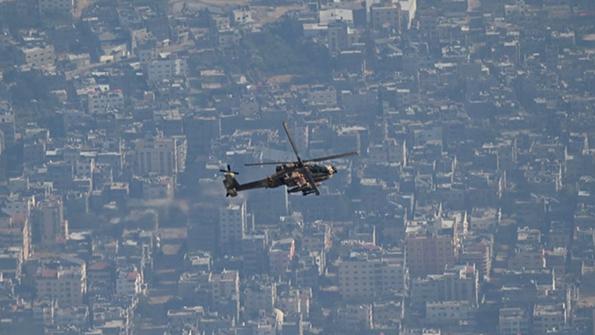
An Israeli AH-64D Apache flew over the Gaza Strip in early November.
At the beginning of 2023, Israel felt relatively safe from a surprise invasion by Iran or an Iranian-backed group, such as Hamas or Hezbollah. The threat of violence was clear, but so was the clarity of Israel’s deterrent: a swift and devastating air attack that would be launched by the Israeli Air Force not only on the invaders, but also on the communities that gave them sanctuary.
But Brig. Gen. Eran Ortal, who retired this year, did not feel so secure. In February, the then-commander of the Dado Center for Interdisciplinary Military Studies, an Israel Defense Forces (IDF) think tank, published his concerns, writing that Israel’s enemies in 2023 could be poised for war—perhaps similar to the Egyptian military on the eve of the Yom Kippur War in 1973.
- Decisive victory strategy makes comeback in defense circles
- Attritional conflict continues push for capacity and acquisition reform
“If [war] breaks out, according to the accepted way of thinking, it will break out as a result of a miscalculation or an uncontrolled escalation,” Ortal wrote in a 19-page monograph titled “Precious Lights: The Warning Lights of 1973 for the IDF in 2023.”
“But is it possible that the Iranian axis may have a different strategic logic?” Ortal added.
On Oct. 7, Hamas provided the answer. Beneath a heavy barrage of rockets aimed at Israeli targets, about 3,000 Hamas and allied fighters stormed across a thinly protected Gaza border. The shock troops massacred hundreds of civilians, sacked several IDF bases and kidnapped scores of hostages within several hours. An enraged Israel responded by declaring war against Hamas, then launched a brutal, air, ground and sea assault on the heavily populated Gaza Strip that was ongoing at press time.
The Hamas-run health ministry is reporting at least 14,800 Palestinians killed as of the end of November. Nearly 400 Israeli soldiers had been killed as of Dec. 1, including at least 70 in fighting after Oct. 7, the IDF said.
The war on Israel’s southern border added another strategic surprise at the beginning of a potentially fraught decade. In the short term, the world must reckon with the potential of regional escalation in the Middle East, the carnage of an ongoing war between Ukraine and Russia and localized flare-ups from the Caucasus to the Sahel region of Africa. In the longer term, terrorism, rogue states and competition between China and the U.S. also pose destabilizing security risks.
But the known risks are only part of the story. A relatively low level of violence persisted for years between Russians and Ukrainians, as well as between Israelis and Palestinians. But neither of the governments in Kyiv nor in Tel Aviv accepted the likelihood of an invasion threat until it was too late in 2022 and 2023, respectively. In an increasingly uncertain age, military and defense industry strategists are adjusting expectations, with the goal of being ready for whatever surprises may come.
In Israel, planning has been underway for a few years. When Ortal was head of the Dado Center in 2019-23, his writings drove a transformation in IDF strategy. Facing nonstate paramilitary forces on its borders, Israel spent decades deterring enemies with the threat of retaliatory air strikes and operating under the protection of Iron Dome air defense batteries. Since 2019, however, Ortal has been calling for a return to a strategy of “decisive victory,” with the IDF assigned to defeat Israel’s enemies through maneuver and assault. Israel’s land attack on Gaza bears the stamp of Ortal’s vision.
In other situations, a decisive victory by the other side seems unlikely. Russia’s attempt to conquer Ukraine in three days will enter a third year of brutal, attrition-style warfare on Feb. 24. The extended fighting will continue to change the landscape of the global defense industry, with a new emphasis from military planners on building industrial capacity and resilient supply chains. Those lessons also are influencing how the U.S. and its allies prepare for a potential conflict with China. While a role remains for exquisite platforms, such as Northrop Grumman B-21 bombers and Columbia-class submarines, U.S. defense officials are seeking new pathways to accelerate the fielding of the kind of cheap and attritable systems that have been proven on the front lines in Ukraine.
